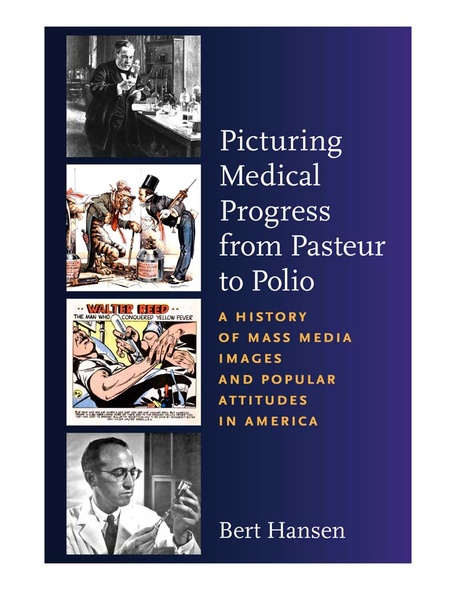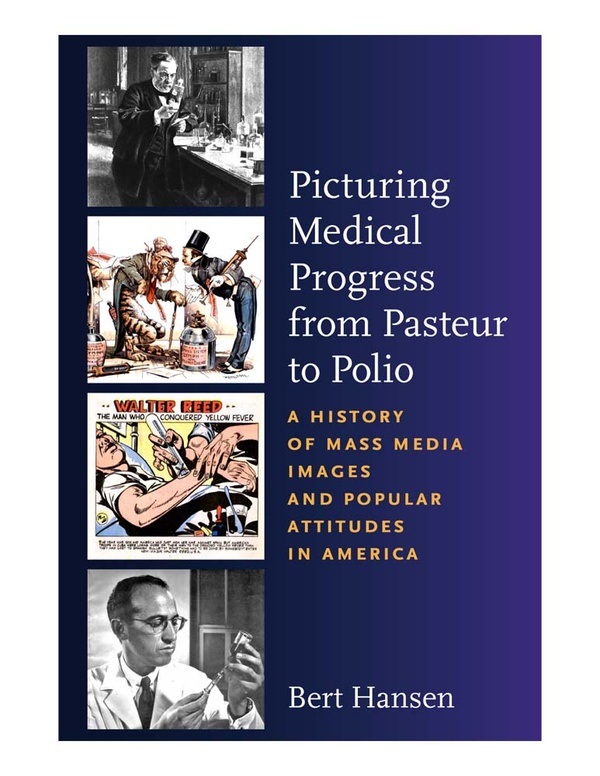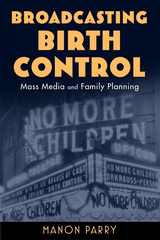Picturing Medical Progress from Pasteur to Polio
A History of Mass Media Images and Popular Attitudes in America
By Bert Hansen
Rutgers University Press
Today, pharmaceutical companies, HMOs, insurance carriers, and the health care system in general may often puzzle and frustrate the general publicùand even physicians and researchers. By contrast, from the 1880s through the 1950s Americans enthusiastically embraced medicine and its practitioners. Picturing Medical Progress from Pasteur to Polio offers a refreshing portrait of an era when the public excitedly anticipated medical progress and research breakthroughs.
This unique study with 130 archival illustrations drawn from newspaper sketches, caricatures, comic books, Hollywood films, and LIFE magazine photography analyzes the relationship between mass media images and popular attitudes. Bert Hansen considers the impact these representations had on public attitudes and shows how media portrayal and popular support for medical research grew together and reinforced each other.
This book is analytical, nostalgic, sensitive, and just plain fun. Bert Hansen's meticulous privileging of the visual is a pathbreaking achievement for methods in the social and cultural history of medicine. You can be rewarded simply by looking at the wonderful pictures, but you will 'see' so much more in his lively prose.
Even as a long-time collector of medical prints, I learned a lot from this extraordinary book. Hansen's digging has turned up many discoveries, providing a new perspective on graphic art in popular culture. The images are wonderful, but this is not just a picture book; it's a great read as well, filled with remarkable insights.
'Picturing Medical Progress from Pasteur to Polio is an authoritative, well-written account that will be a significant contribution not only to the history of American medicine, but to the history of American popular culture.'
This skillfully written volume reminds us how books such as Microbe Hunters, films such as Dr. Ehrlich's Magic Bullet, and even some of the old comic books and Life magazines in our basements once celebrated medical history and inspired the young to study science and medicine. Bert Hansen's rich exploration of the intersection of popular culture and the history of medicine opens wide a window on a time between the 1880s and the 1950s when physicians, nurses, and scientists were highly regarded warriors against disease and human suffering. It is a major contribution to our understanding of how medicine's cultural authority was established and expanded in the United States, vital to scholars and valuable to those who hope to spark a renewed enthusiasm among Americans for the study of science and medicine.
That doctors and their work routinely populate all forms of popular American culture is a historical aberration. Bert Hansen begins his illustrated account of the start of this phenomenon with the observation that until late in the 19th century, no one really wanted any more contact with doctors than was necessary-certainly not in publications intended to entertain. Louis Pasteur changed all that. As scientific triumphs accumulated, the hagiography of the doctor spread throughout the media, from print advertisements to radio spots, from comic books to adoring photo essays in Life magazine.
Hansen's narrative reveals a remarkably rich engagement between laboratory work and the curiosity of ordinary citizens. Hansen's work is well grounded in primary research and includes the footnotes expected by medical historians, but at the same time it is completely accessible to any reader interested in the history of medicine. Hansen has done an admirable job of excavating the role played by images of medical progress in the popular media. Picturing Medical Progress From Pasteur to Polio is both a remarkable work of medical history and an entertaining account of medicine's golden age viewed through the eyes of the public.
At the start, the practice of medicine is accorded little positive public recognition. The medical profession as pictured in magazines and newspapers is ineffective and unprofessional, in collusion with the funeral industry, and tolerant of inferior public health. By the 1950s, with the advent of the Salk polio vaccine, medicine has become a highly esteemed profession grounded in scientific research. Hansen documents the transition, making a detailed examination of images in both print and film media. Recommended.
For historians of all kinds, whether of science, of medicine, or of media, Hansen's book provides a strong argument for paying more attention to images.
This is the best synthetic treatment we have of the role the mass media played in shaping and promoting the high esteem enjoyed by the American medical profession across the first half of the twentieth century. Hansen has given us both a richly detailed account of the images widely circulated to the public and a convincing analysis of the aggregate image those pictures of medicine fostered.
Hansen presents material previously unexplored by medical historians, while maintaining a clear narrative style.
This book is analytical, nostalgic, sensitive, and just plain fun. Bert Hansen's meticulous privileging of the visual is a pathbreaking achievement for methods in the social and cultural history of medicine. You can be rewarded simply by looking at the wonderful pictures, but you will 'see' so much more in his lively prose.
Even as a long-time collector of medical prints, I learned a lot from this extraordinary book. Hansen's digging has turned up many discoveries, providing a new perspective on graphic art in popular culture. The images are wonderful, but this is not just a picture book; it's a great read as well, filled with remarkable insights.
'Picturing Medical Progress from Pasteur to Polio is an authoritative, well-written account that will be a significant contribution not only to the history of American medicine, but to the history of American popular culture.'
This skillfully written volume reminds us how books such as Microbe Hunters, films such as Dr. Ehrlich's Magic Bullet, and even some of the old comic books and Life magazines in our basements once celebrated medical history and inspired the young to study science and medicine. Bert Hansen's rich exploration of the intersection of popular culture and the history of medicine opens wide a window on a time between the 1880s and the 1950s when physicians, nurses, and scientists were highly regarded warriors against disease and human suffering. It is a major contribution to our understanding of how medicine's cultural authority was established and expanded in the United States, vital to scholars and valuable to those who hope to spark a renewed enthusiasm among Americans for the study of science and medicine.
That doctors and their work routinely populate all forms of popular American culture is a historical aberration. Bert Hansen begins his illustrated account of the start of this phenomenon with the observation that until late in the 19th century, no one really wanted any more contact with doctors than was necessary-certainly not in publications intended to entertain. Louis Pasteur changed all that. As scientific triumphs accumulated, the hagiography of the doctor spread throughout the media, from print advertisements to radio spots, from comic books to adoring photo essays in Life magazine.
Hansen's narrative reveals a remarkably rich engagement between laboratory work and the curiosity of ordinary citizens. Hansen's work is well grounded in primary research and includes the footnotes expected by medical historians, but at the same time it is completely accessible to any reader interested in the history of medicine. Hansen has done an admirable job of excavating the role played by images of medical progress in the popular media. Picturing Medical Progress From Pasteur to Polio is both a remarkable work of medical history and an entertaining account of medicine's golden age viewed through the eyes of the public.
At the start, the practice of medicine is accorded little positive public recognition. The medical profession as pictured in magazines and newspapers is ineffective and unprofessional, in collusion with the funeral industry, and tolerant of inferior public health. By the 1950s, with the advent of the Salk polio vaccine, medicine has become a highly esteemed profession grounded in scientific research. Hansen documents the transition, making a detailed examination of images in both print and film media. Recommended.
The work is an authoritative, well-written account that will not only be a significant contribution to the history of American medicine, but to the history of American popular culture. It is nostalgic, analytical, and just plain fun with remarkable insights and delightful illustrations from newspaper sketches, caricatures, comic books and Hollywood films.
For historians of all kinds, whether of science, of medicine, or of media, Hansen's book provides a strong argument for paying more attention to images.
This is the best synthetic treatment we have of the role the mass media played in shaping and promoting the high esteem enjoyed by the American medical profession across the first half of the twentieth century. Hansen has given us both a richly detailed account of the images widely circulated to the public and a convincing analysis of the aggregate image those pictures of medicine fostered.
Hansen presents material previously unexplored by medical historians, while maintaining a clear narrative style.
Bert Hansen, a professor of history at Baruch College, has published a book on medieval science and many articles on the history of modern medicine and public health.
Part 1. The Setting
Medicine in the Public Eye, Then and Now
Before There Were Medical Breakthroughs
Part 2. A New Regime of Medical Progress
How Medicine Became Hot News, 1885
Popular Enthusiasm for Laboratory Discoveries, 1885-1895
Creating an Institutional Base for Medical Research,1890-1920
Part 3. Medical History for the Public, 1925-1950
The Mass Media Make Medical History Popular
"And now, a word from our sponsor"
Popular Medical History in Children's Comic Books of the 1940s
Part 4. The Modern Imagery of Medical Progress
Life Looks at Medicine
The Meaning of an Era
Appendix
Notes
Index
Medicine in the Public Eye, Then and Now
Before There Were Medical Breakthroughs
Part 2. A New Regime of Medical Progress
How Medicine Became Hot News, 1885
Popular Enthusiasm for Laboratory Discoveries, 1885-1895
Creating an Institutional Base for Medical Research,1890-1920
Part 3. Medical History for the Public, 1925-1950
The Mass Media Make Medical History Popular
"And now, a word from our sponsor"
Popular Medical History in Children's Comic Books of the 1940s
Part 4. The Modern Imagery of Medical Progress
Life Looks at Medicine
The Meaning of an Era
Appendix
Notes
Index








